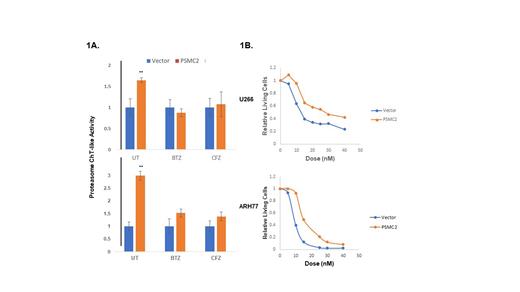Background: Multiple myeloma (MM) remains a highly treatable but generally incurable plasma cell dyscrasia. These plasma cells synthesize massive amounts of paraprotein relying heavily on the ubiquitin proteasome system to maintain homeostasis and are exquisitely sensitive to proteasome inhibition to avoid terminal ER stress. We postulated that increased expression of clinically relevant proteasome subunits would correlate with reduced overall survival in MM patients treated with proteasome inhibitors.
Objective: To correlate proteasome gene expression levels to clinicals outcomes in both the phase III APEX trial and the MMRF COMMPASS Trial. To model the effects of these hits on MMCL UPS function.
Results: We identified that 19S regulatory ATPases PSMC2 and PSMC6 correlated with poorer OS, outperforming the proteasome inhibitor (PI) target, PSMB5, in this analysis. We focused on modeling the more frequently upregulated PSMC2. We created PSMC2 overexpressing multiple myeloma cell lines, noting PSMC2 is readily incorporated in the higher order proteasome complexes. PSMC2 overexpressing cells exhibit higher levels of 20S proteasome activity (1.6 fold increase in ARH77 and 3 fold increase in U266 cell line compared to control, p< 0.01 in each case) and are more resistant to PI challenge (Bortezomib LD 50 of 30 nM v 15 nM in U266 overexpressed and control cells respectively, Bortezomib LD 50 of 18 nM v 10 nM in ARH77 overexpressed v control cells respectively). PIs are known to increase ER stress, and PSMC2 overexpressing cells are better able to mitigate PI mediated ER stress with PSMC2 overexpressing cells exhibiting less induction of ER stress sensors p-IRE1α and ATF4 compared to PSMC2 knockdown cells on bortezomib or tunicamycin challenge as quantitated by western blotting and utilizing an fluorescent ER stress sensor that models the conversion of XBP1u to XBP1s by pIRE1α. Mechanistically, PSMC subunits play a key role in the recognition and degradation of misfolded ER proteins, and increased 19S subunits may allow more effective ER associated protein degradation (ERAD)
Conclusions: Taken together, our results suggest PSMC2 overexpression correlates with reduced OS in MM patients treated with bortezomib and that PSMC2 may represent an actionable therapeutic target to prevent or overcome PI resistance. PSMC2 overexpression increases proteasome activity in MM cells, mitigates ER stress on PI challenge and promotes PI resistance. mitigates ER stress upon PI challenge, and portending poorer clinical prognosis and more drug resistance, suggesting that 19S targeted agents may help overcome drug resistance in MM.
Figure 1 A. PSMC2 overexpression increases chymotrypsin-like proteasome activity at baseline in U266 and ARH77 cells with a similar effect of residual proteasome activity after challenge with bortezomib or carfilzomib. B. ARH77 and U266 FLAG and vector cells were challenged with bortezomib for 18 hrs and then assayed by annexin PI staining. LD50 increased from 10 nm to 15 nm in ARH77 cells and from 12 to 25 in U266 Cells.
Disclosures
Malek:Amgen: Speakers Bureau; Sanofi: Consultancy; BMS: Consultancy; Karyopharm: Speakers Bureau; Medpacto Inc.: Research Funding; Cumberland Inc.: Research Funding.


